Optimizing Intermittent Water Injection Cycles to Mitigate Asphaltene Formation: A Reservoir Simulation Approach
Abstract
1. Introduction
2. Mitigation Strategies and Modeling Framework
2.1. Thermodynamic Precipitation Modeling
2.2. Asphaltene Flocculation
2.3. Asphaltene Deposition and Plugging
2.4. Rock Property Degradation
2.5. Oil Viscosity Modification
- (1)
- Einstein Model (one parameter)
- (2)
- Krieger–Dougherty Model
- (3)
- Tabulated Data
3. Results Analysis and Discussion
3.1. Production Trends and Saturation Changes
3.2. Reservoir Shut-In Time Sensitivity
3.3. Spatial Deposition Trends Under Shut-In Sensitivity
3.4. Injection Rate Sensitivity
3.4.1. Deposition Trends at Key Locations
3.4.2. Plugging and Permeability Impairment
3.4.3. Operational Implications
3.5. Time of Injection Sensitivity
3.5.1. Deposition Behavior Across Injection Timing
3.5.2. Mechanistic Interpretation and System Re-Stabilization
- (1)
- Reservoir destabilization during depletion:
- (2)
- Partial re-stabilization during water injection:
3.6. Comparison of Traditional W.F. to I.W.F. Effects on Asphaltene Damage
3.6.1. Deposition Comparison at Key Locations
3.6.2. Field Implications
4. Conclusions
- (1)
- Shut-in time beyond a few days offers negligible additional benefit in reducing deposition, suggesting that extended reservoir idle periods delay recovery without significantly improving flow conditions.
- (2)
- Spatial trends show that the producer region consistently experiences the highest deposition, plugging, and permeability damage, largely due to pressure drawdown and streamline convergence.
- (3)
- Higher injection rates reduce near-wellbore deposition and shorten injection duration, offering both flow assurance and economic advantages.
- (4)
- Earlier injection timing helps stabilize the reservoir system before irreversible precipitation and flocculation occur, thereby minimizing cumulative damage.
- (5)
- Compared to traditional waterflooding, IWF substantially reduces asphaltene deposition at all key locations, particularly near the producer. This advantage is attributed to the re-pressurization phase that interrupts and reverses the flocculation-deposition cycle.
Supplementary Materials
Author Contributions
Funding
Data Availability Statement
Conflicts of Interest
References
- Arunagiri, A.T.; Gnanasundaram, N.; Wilfred, C.D.; Rashid, Z.; Murugesan, T. A comprehensive review on recent advances in petroleum asphaltene aggregation. J. Pet. Sci. Eng. 2019, 176, 249–268. [Google Scholar] [CrossRef]
- Mohammed, I.; Mahmoud, M.; Al Shehri, D.; El-Husseiny, A.; Alade, O. Asphaltene precipitation and deposition: A critical review. J. Pet. Sci. Eng. 2020, 197, 107956. [Google Scholar] [CrossRef]
- Carrera, M.; Zarooni, M.; Olayiwola, O.; Nguyen, V.; Boukadi, F. Impacts of asphaltene deposition on oil recovery following a waterflood—A numerical simulation study. J. Pet. Chem. Eng. 2024, 2, 1–8. [Google Scholar] [CrossRef]
- Ghadimi, M.; Ghaedi, M.; Malayeri, M.R.; Amani, M.J. A new approach to model asphaltene induced permeability damage with emphasis on pore blocking mechanism. J. Pet. Sci. Eng. 2020, 184, 106512. [Google Scholar] [CrossRef]
- Fahes, M.; Abraham, J.; Mehana, M. The impact of asphaltene deposition on fluid flow in sandstone. J. Pet. Sci. Eng. 2019, 174, 676–681. [Google Scholar] [CrossRef]
- Khurshid, I.; Al-Attar, H.; Alraeesi, A.R. Modeling cementation in porous media during waterflooding: Asphaltene deposition, formation dissolution, and their cementation. J. Pet. Sci. Eng. 2018, 161, 359–367. [Google Scholar] [CrossRef]
- Qi, J.; Fan, C.; Li, S. Characteristics of lignite char derived from oxy-pyrolysis. Fuel 2021, 291, 120261. [Google Scholar] [CrossRef]
- Lo, P.A.; Tinni, A.O.; Milad, B. Experimental study on the influence of flow rate and pressure on the deposition of asphaltenes in a sandstone core sample. Fuel 2022, 310, 122420. [Google Scholar] [CrossRef]
- Stratiev, D.; Nikolova, R.; Veli, A.; Shishkova, I.; Toteva, V.; Georgiev, G. Mitigation of asphaltene deposit formation via chemical additives: A review. Processes 2025, 13, 141. [Google Scholar] [CrossRef]
- Shekarifard, A.; Shakib-Taheri, J.; Naderi, H. Experimental investigation of asphaltene deposition in porous media under ultrasonic and microwave fields. J. Pet. Sci. Eng. 2018, 163, 453–462. [Google Scholar] [CrossRef]
- Xiong, R.; Guo, J.; Kiyingi, W.; Li, Q. Method for judging the stability of asphaltenes in crude oil. ACS Omega 2020, 5, 23131–23140. [Google Scholar] [CrossRef] [PubMed]
- Tahernejad, E.; Bazvand, M.; Shadizadeh, S.R. Asphaltene Deposition Effects on Reservoir Rock Wettability and Permeability: An Experimental Study. Sci. Rep. 2024, 14, 15249. [Google Scholar] [CrossRef]
- Mehrabi, A.; Bagheri, M.; Nabi Bidhendi, M.; Delijani, E.B.; Behnood, M. Porosity estimation of carbonate reservoirs using a hybrid deep neural network model based on well data. Iran. J. Geophys. 2024, 18, 143–164. [Google Scholar] [CrossRef]
- Ali, S.I.; Lalji, S.M.; Haneef, J.; Tariq, S.M.; Junaid, M.; Ali, S.M.A. Determination of asphaltene stability in crude oils using a deposit level test coupled with a spot test: A simple and qualitative approach. ACS Omega 2022, 7, 14165–14179. [Google Scholar] [CrossRef] [PubMed]
- Saboor, A.; Yousaf, N.; Haneef, J.; Ali, S.I. Performance of asphaltene stability predicting models in field environment and development of a new predictor. J. Pet. Explor. Prod. Technol. 2022, 12, 1423–1436. [Google Scholar] [CrossRef]
- Moosavi, N.; Bagheri, M.; Nabi-Bidhendi, M. Hydrocarbon Reservoir Parameter Estimation Using a Fuzzy Gaussian Based SVR Method. Bull. Geophys. Oceanogr. 2024, 65, 1–14. Available online: https://bgo.ogs.it/sites/default/files/pdf/bgo00454_Moosavi.pdf (accessed on 24 May 2025).
- Hassanpouryouzband, A.; Joonaki, E.; Taghikhani, V.; Bozorgmehry Boozarjomehry, R.; Chapoy, A.; Tohidi, B. New two-dimensional particle-scale model to simulate asphaltene deposition in wellbores and pipelines. Energy Fuels 2018, 32, 2661–2672. [Google Scholar] [CrossRef]
- Mohebbinia, S.; Sepehrnoori, K.; Johns, R.T.; Kazemi Nia Korrani, A. Simulation of asphaltene precipitation during gas injection using PC-SAFT EOS. J. Pet. Sci. Eng. 2017, 158, 693–706. [Google Scholar] [CrossRef]
- Wang, S.; Civan, F. Preventing Asphaltene Deposition in Oil Reservoirs by Early Water Injection. In SPE Production Operations Symposium, Society of Petroleum Engineers; SPE: St Bellingham, WA, USA, 2005. [Google Scholar]
- Imqam, A.; Elturki, M. Experimental investigation of asphaltene deposition and aggregation in ultra-low permeability reservoirs under CO2 injection. In Proceedings of the SPE Canada Energy Technology Conference, Calgary, AB, Canada, 16–17 March 2022. SPE-208563-MS. [Google Scholar]
- Yin, D.; Li, Q.; Zhao, D. Investigating asphaltene precipitation and deposition in ultra-low permeability reservoirs during CO2-EOR. Sustainability 2023, 16, 4303. [Google Scholar] [CrossRef]
- Choiri, M.; Hamouda, A.A. Enhanced Oil Recovery by CO2 Flooding Effect on Asphaltene Stability Envelope and Compositional Simulation of Asphaltenic Oil Reservoir; SPE 141329; SPE: St Bellingham, WA, USA, 2011. [Google Scholar]
- Hussain, M.; Boukadi, F.; Hu, Z.; Adjei, D. Optimizing oil recovery: A sector model study of CO2-water-alternating-gas and continuous injection technologies. Processes 2025, 13, 700. [Google Scholar] [CrossRef]


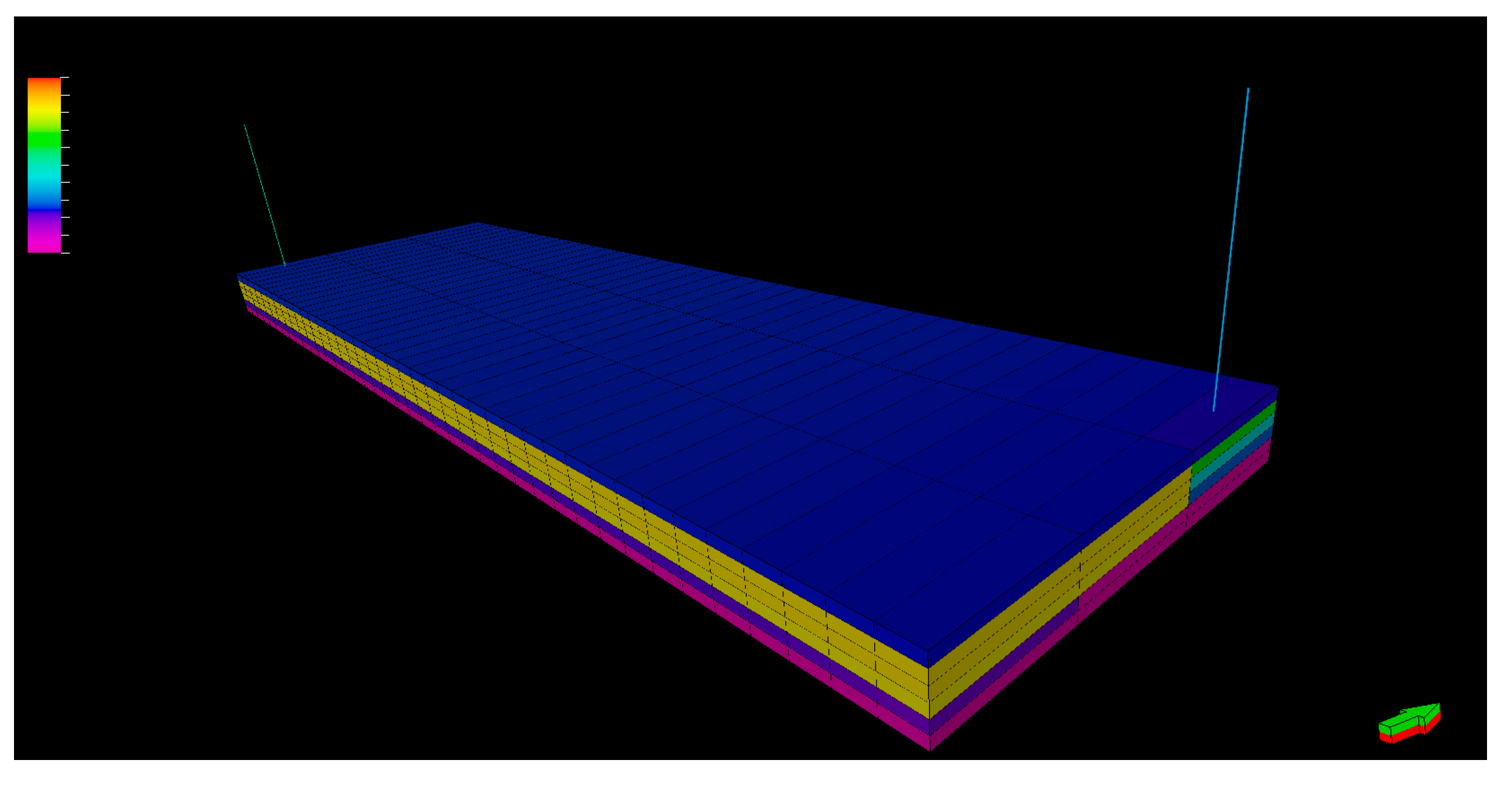






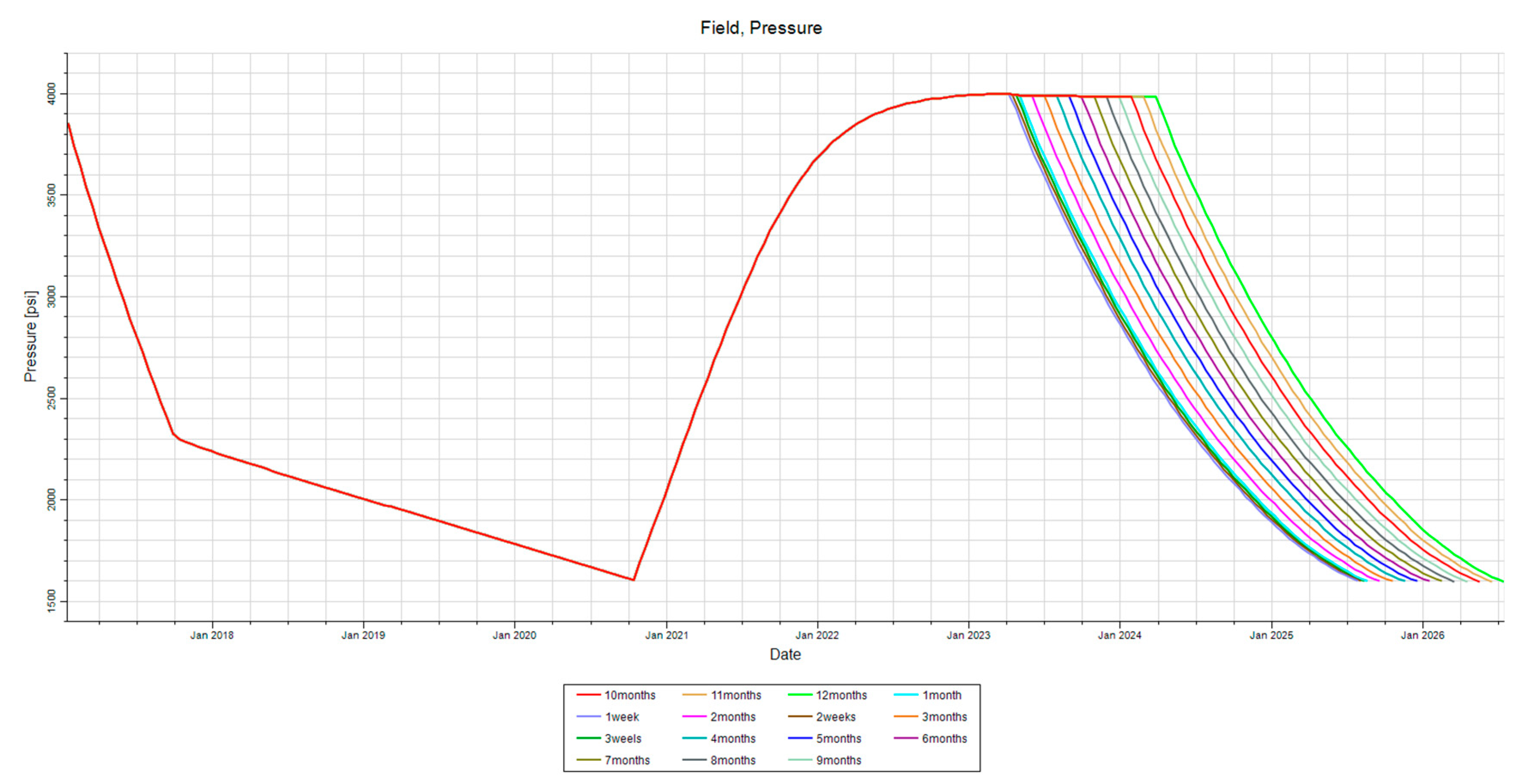
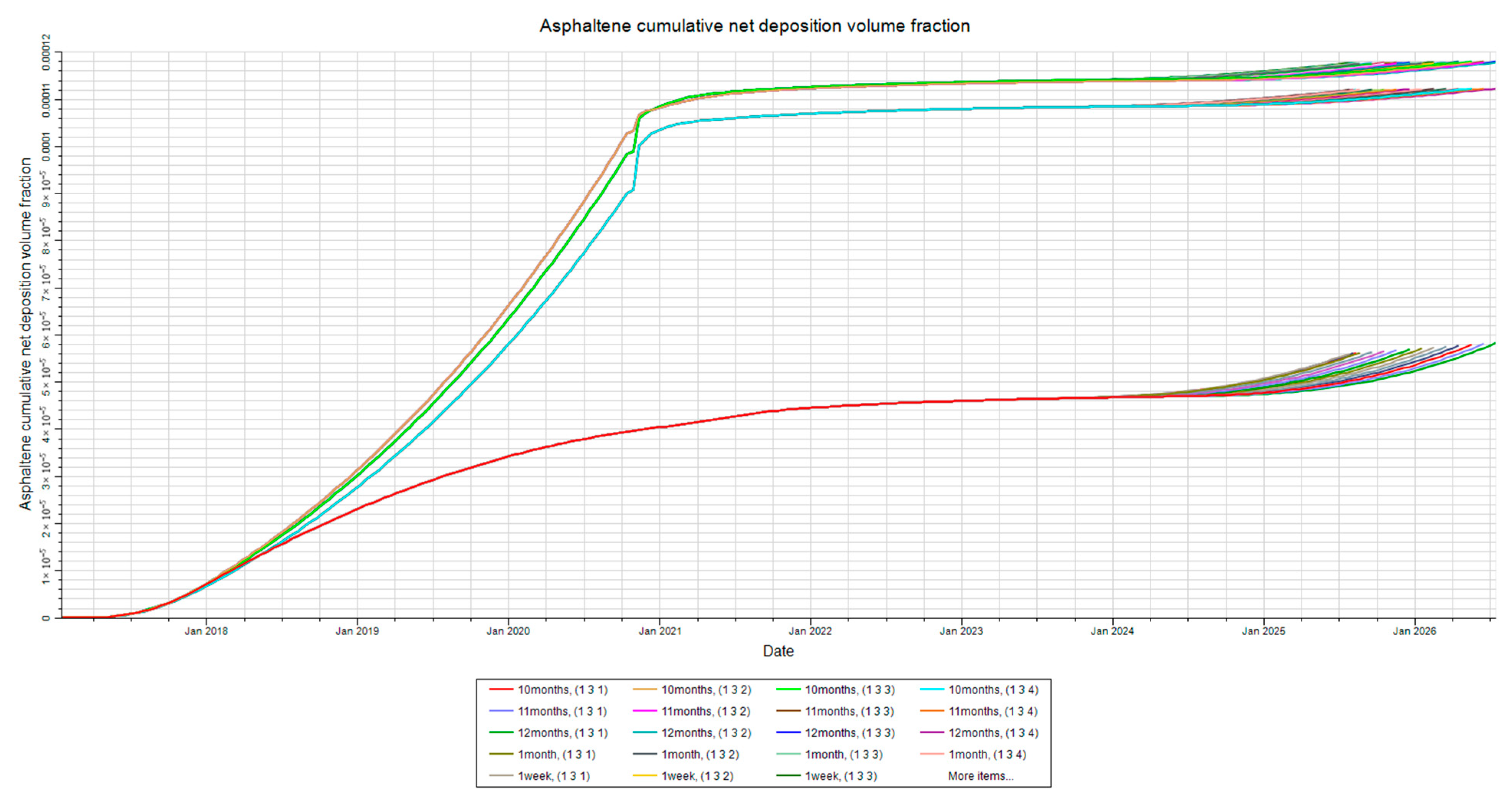


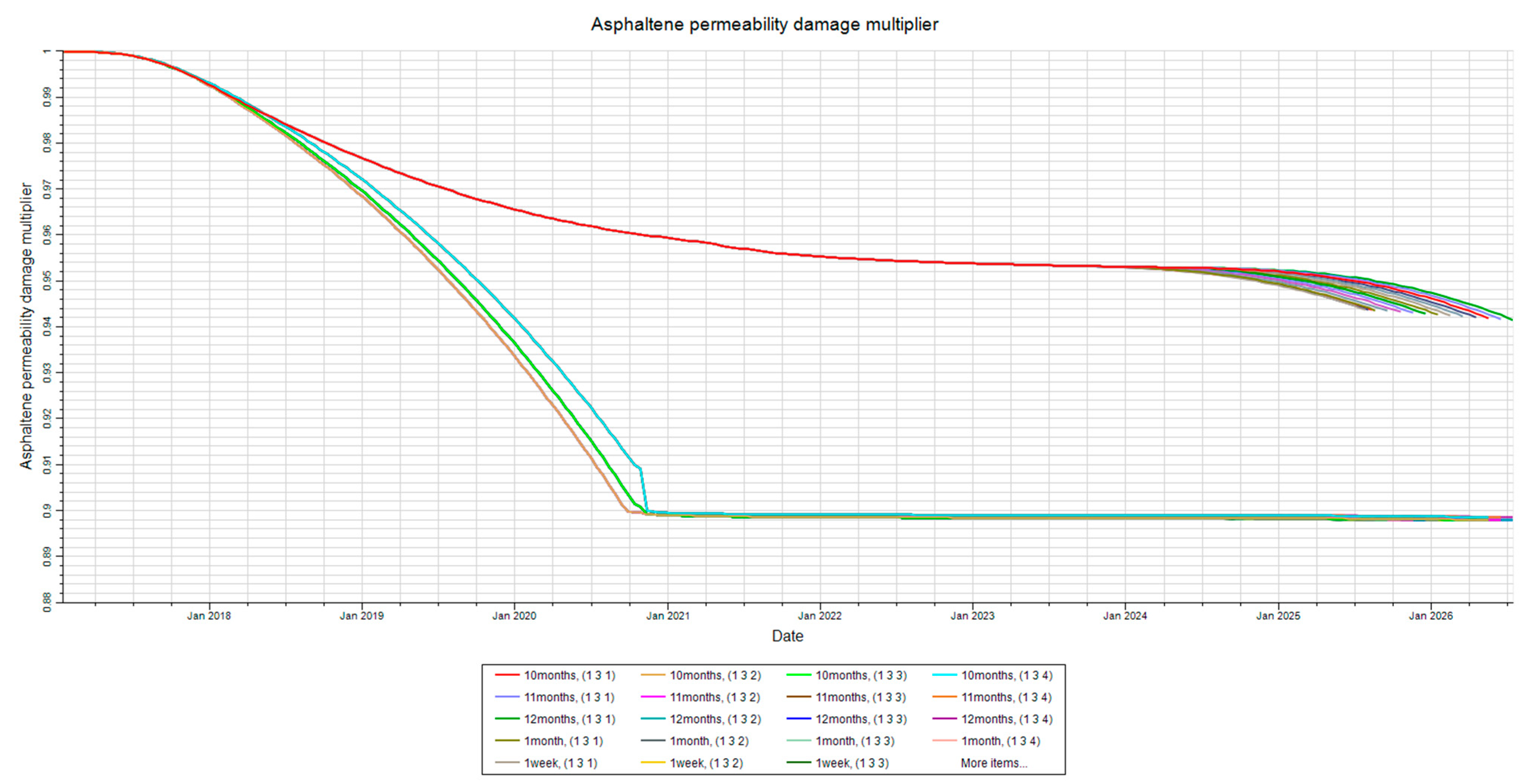

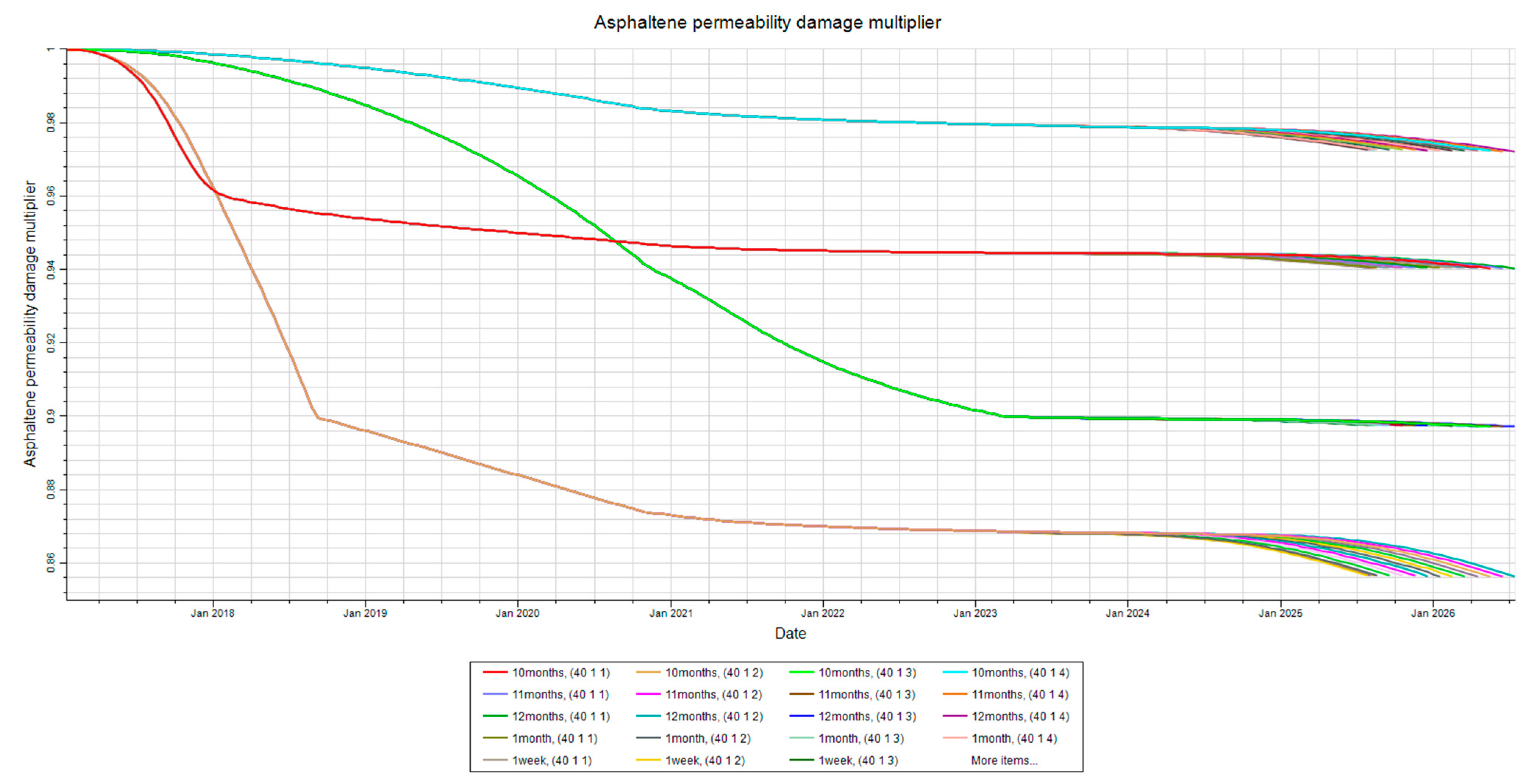
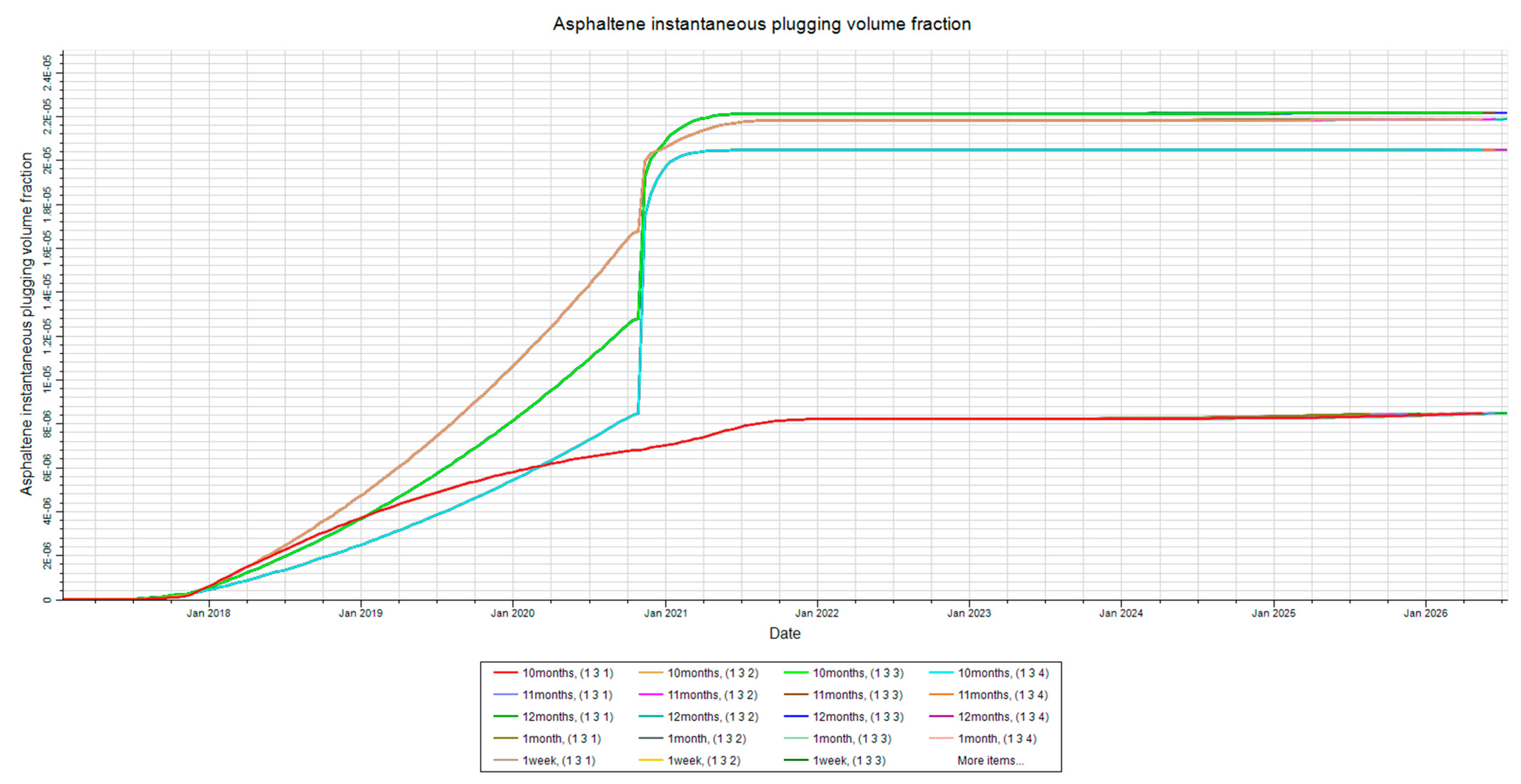
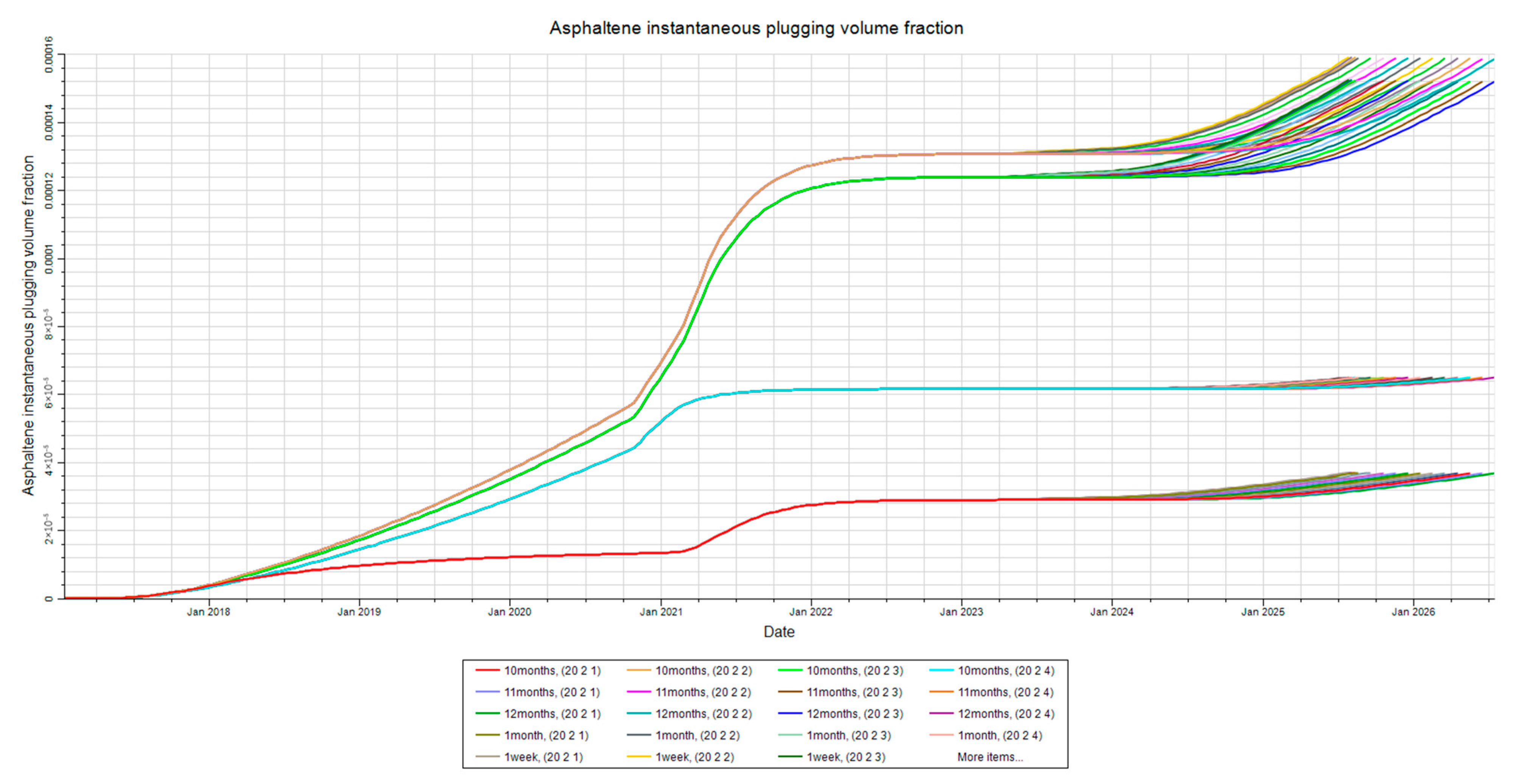


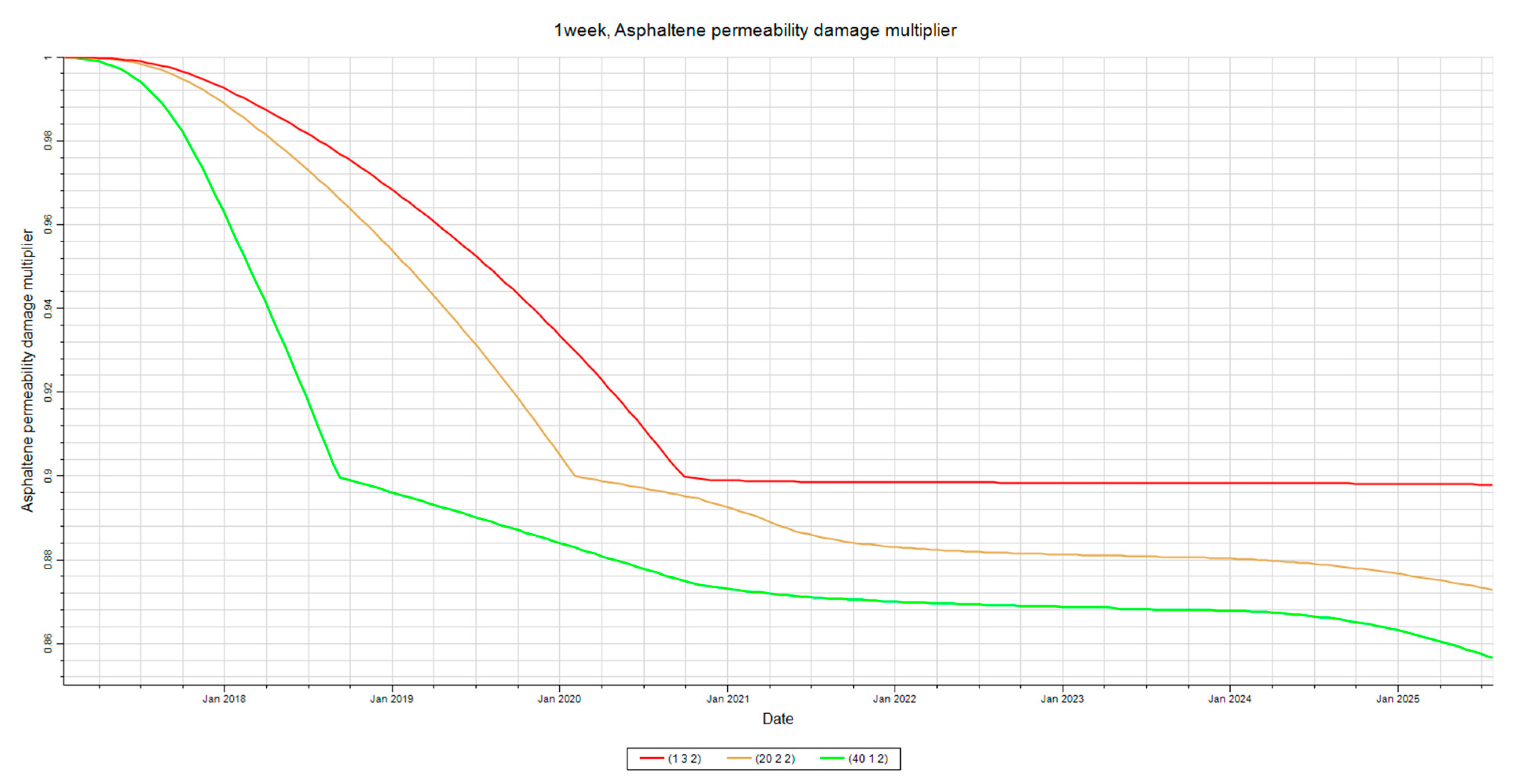


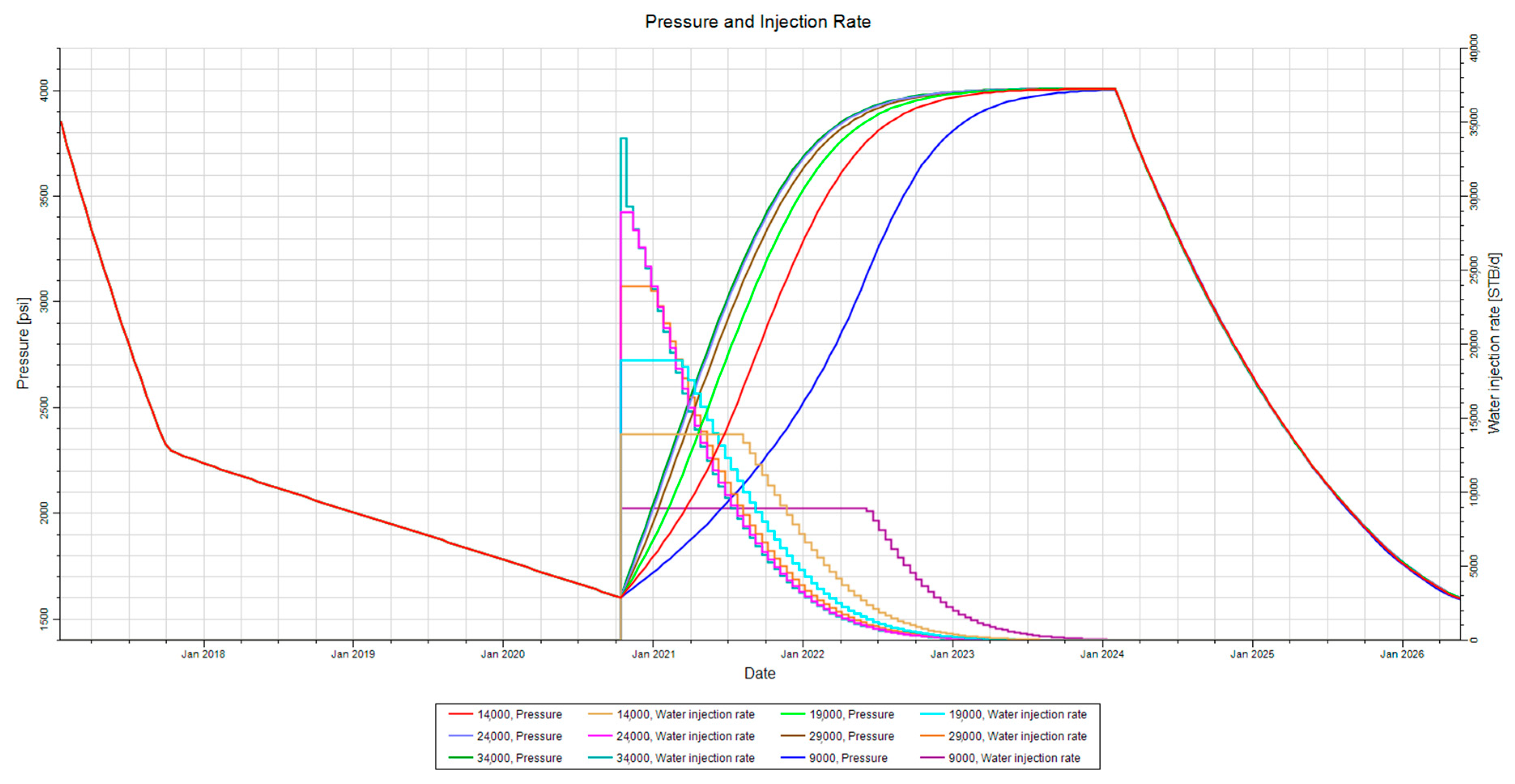

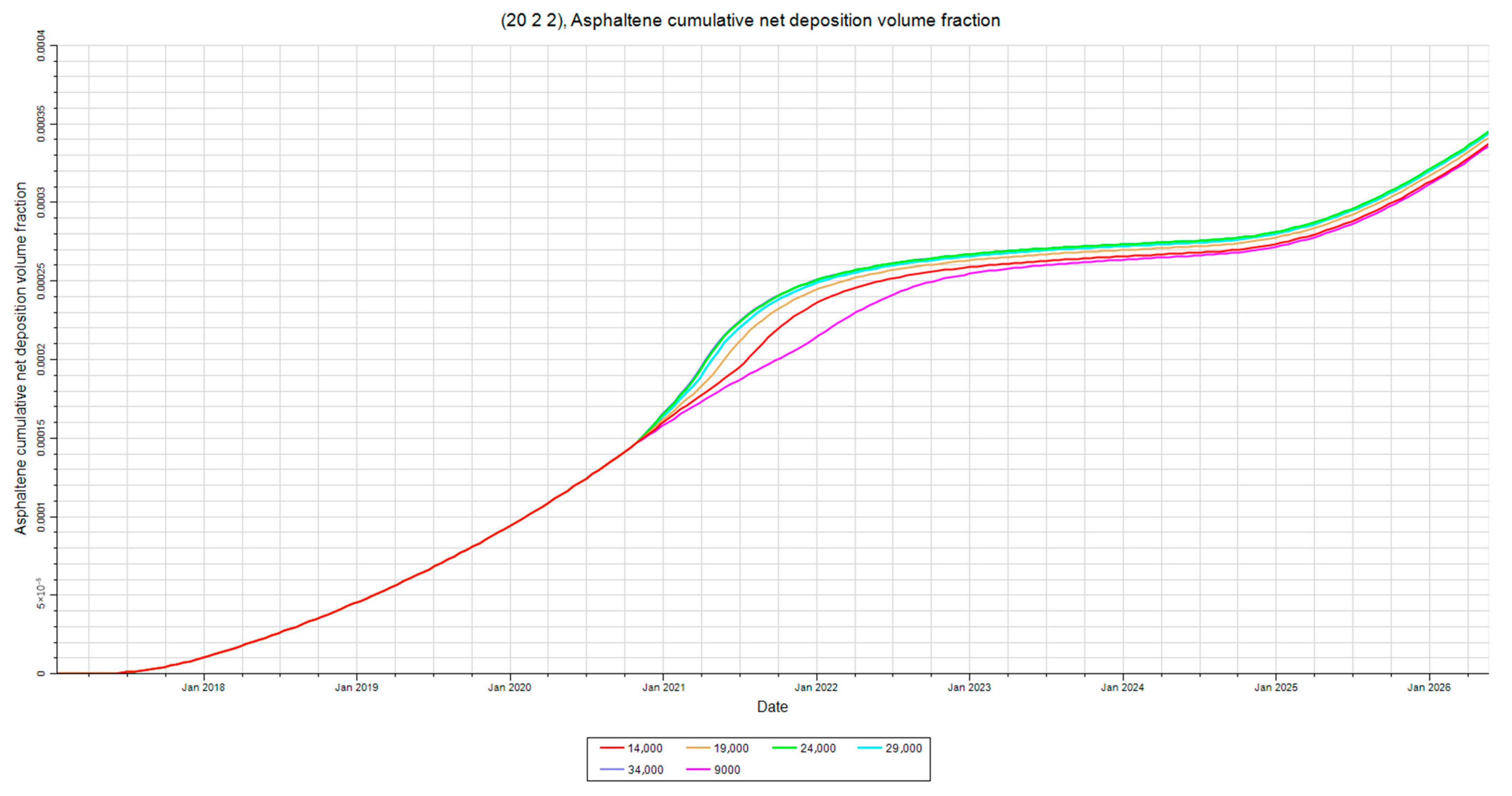
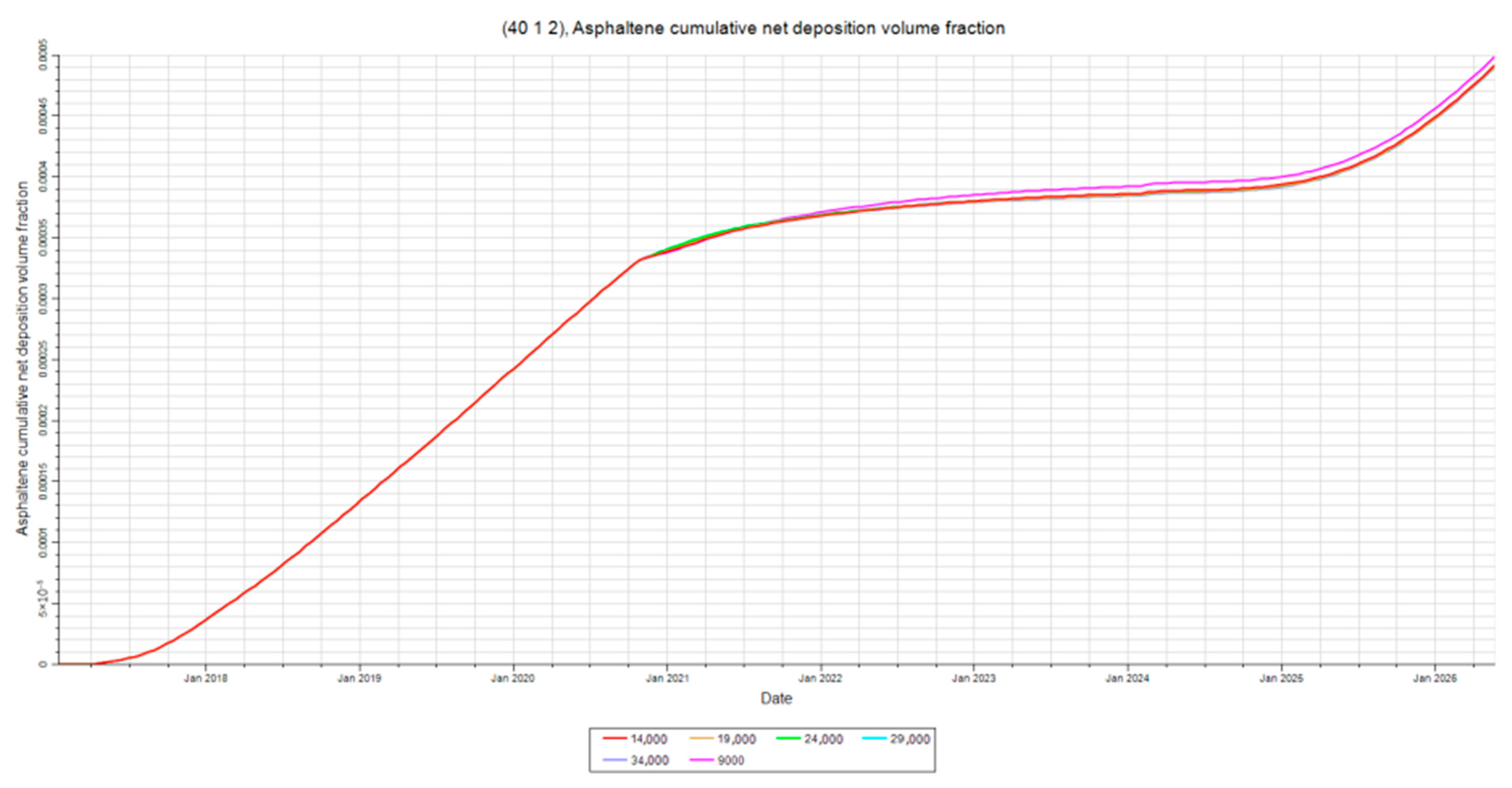
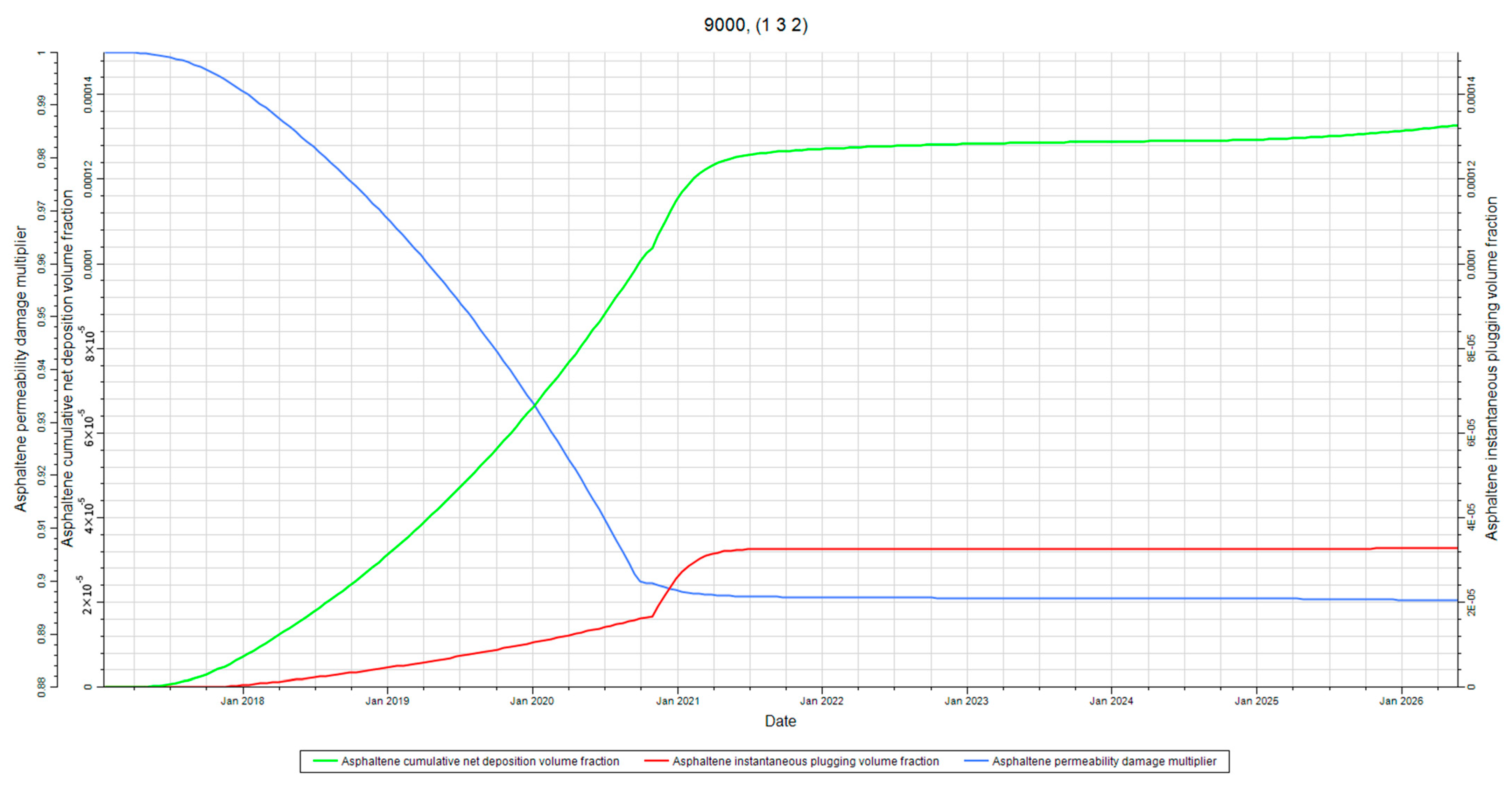

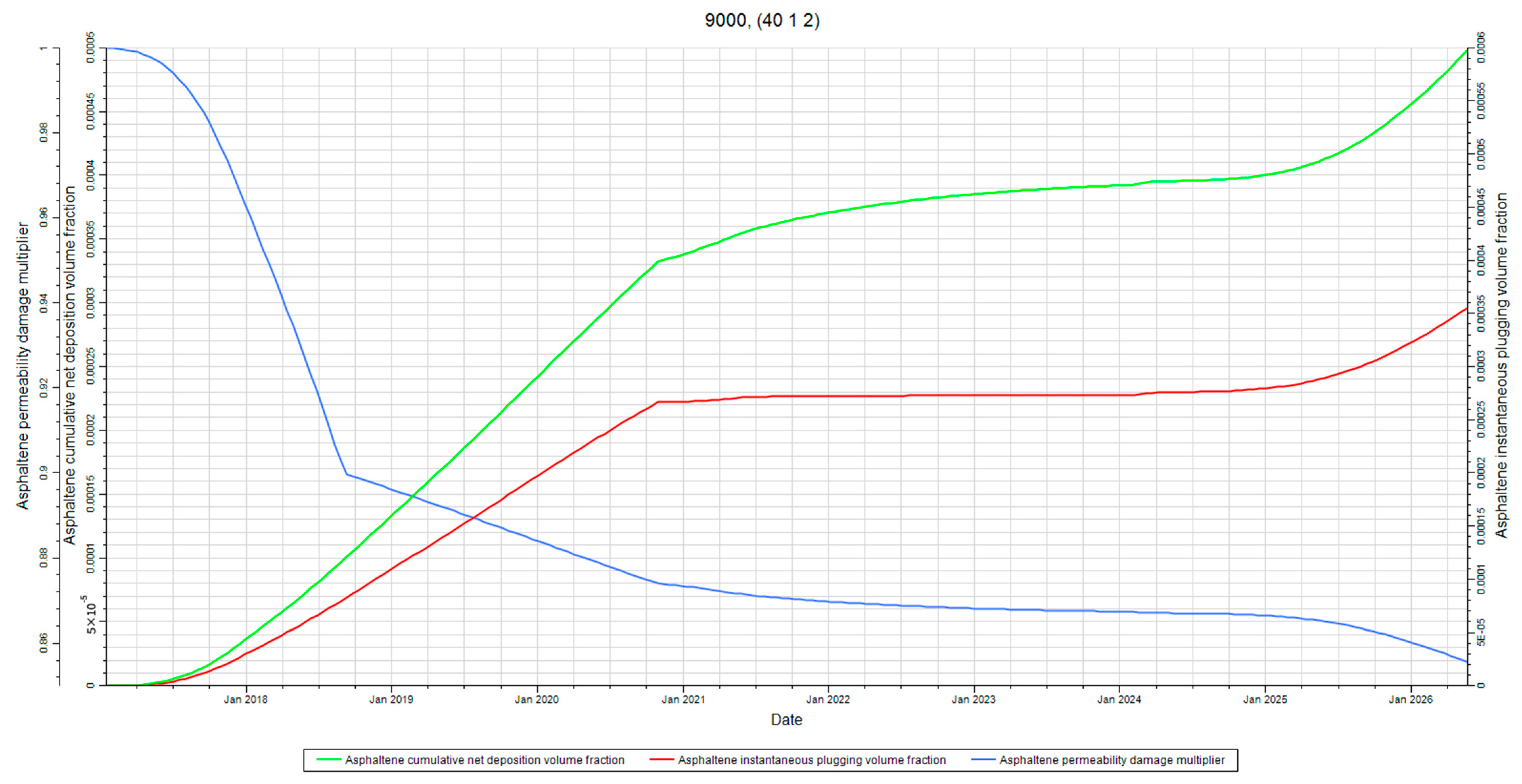

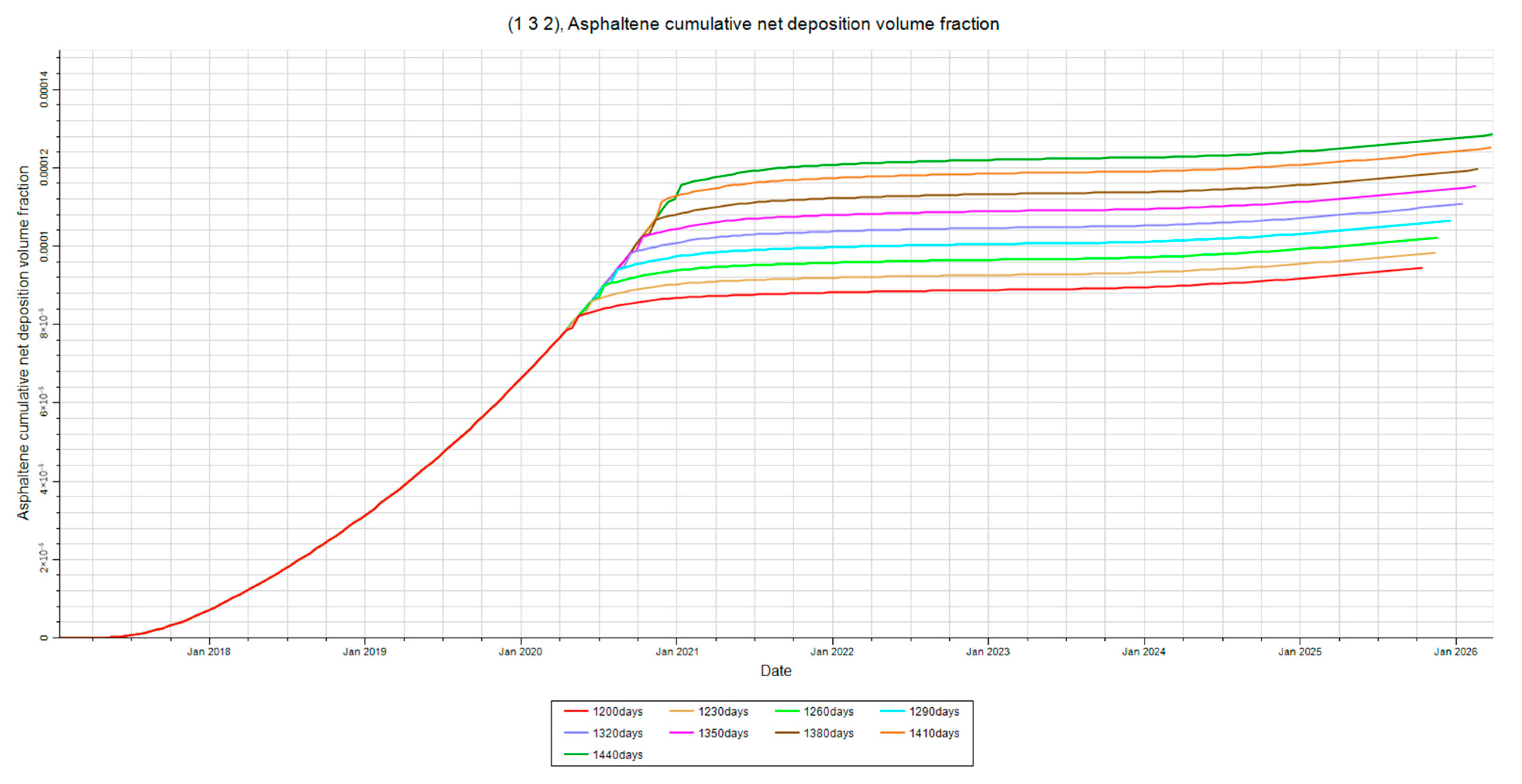
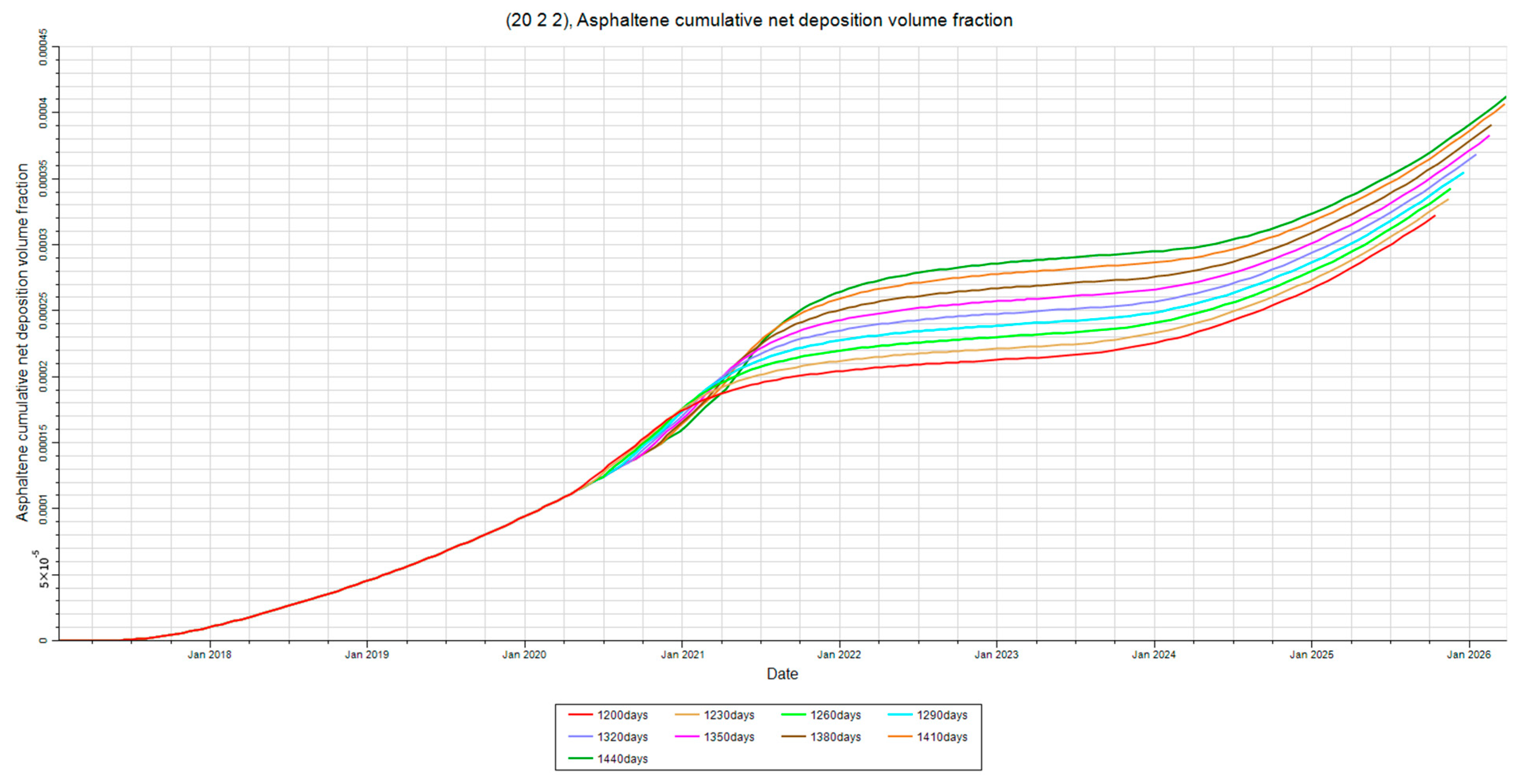
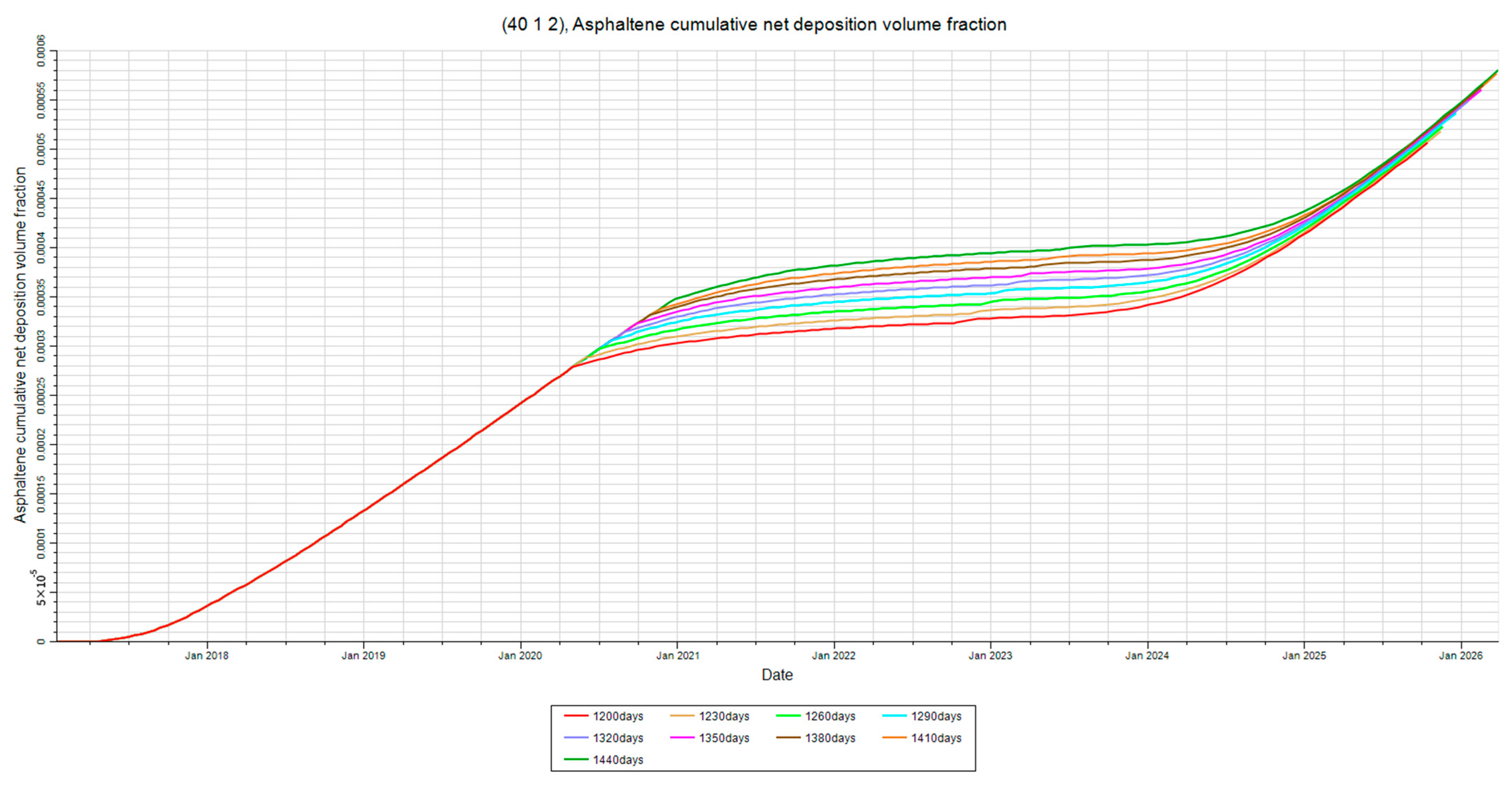

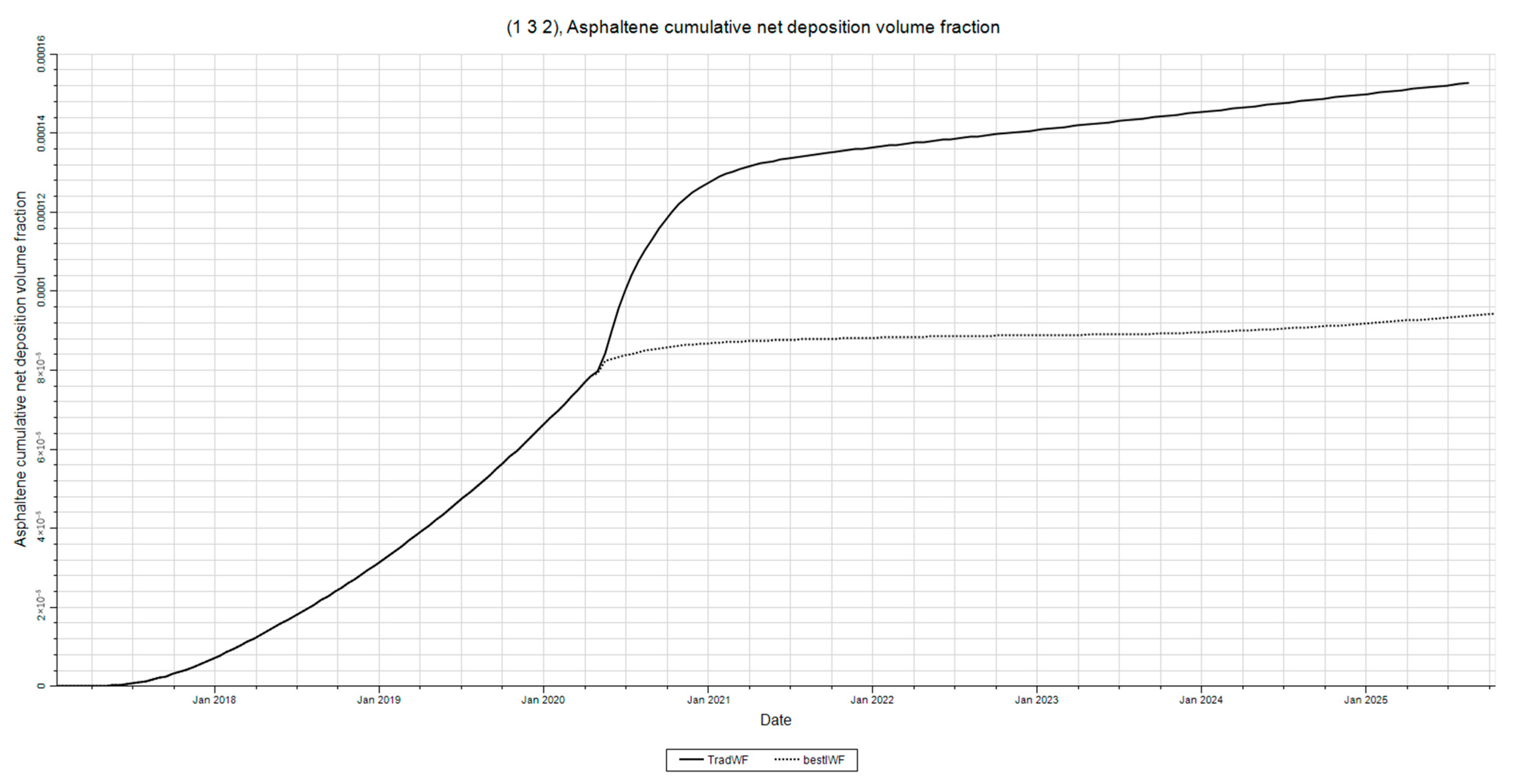


| Symbol | Parameter | Value | Unit |
|---|---|---|---|
| α | Adsorption coefficient | 5.0 × 10−4 | - |
| β | Plugging coefficient | 1.0 × 10−6 | - |
| γ | Critical velocity | 1.0 × 10−4 | - |
| Vcr | Critical velocity | 2500 | Ft/day |
| η | Flocculation rate | 0.01/0.001 | - |
| Parameter | Value |
|---|---|
| Temperature | 160 °F (constant) |
| Initial Saturations | Sw = 0.16; So = 0.84 |
| Oil Composition | C1-C20 + ASPH (7 components) |
| Injection Rate (stb/day) | Injector Deposition (vfrac) | Mid-Point Deposition | Producer Deposition | Approx. Max Permeability Reduction |
|---|---|---|---|---|
| 10,000 | 0.032 | 0.024 | 0.028 | 18% |
| 16,000 | 0.027 | 0.030 | 0.025 | 15% |
| 19,000 | 0.026 | 0.033 | 0.021 | 12% |
| 24,000 | 0.024 | 0.035 | 0.020 | 10% |
| 29,000 | 0.022 | 0.037 (highest) | 0.018 (lowest) | 8% |
Disclaimer/Publisher’s Note: The statements, opinions and data contained in all publications are solely those of the individual author(s) and contributor(s) and not of MDPI and/or the editor(s). MDPI and/or the editor(s) disclaim responsibility for any injury to people or property resulting from any ideas, methods, instructions or products referred to in the content. |
© 2025 by the authors. Licensee MDPI, Basel, Switzerland. This article is an open access article distributed under the terms and conditions of the Creative Commons Attribution (CC BY) license (https://creativecommons.org/licenses/by/4.0/).
Share and Cite
Moorman, E.D.; Xue, J.; Ibrahim, I.; Okeke, N.; Trabelsi, R.; Trabelsi, H.; Boukadi, F. Optimizing Intermittent Water Injection Cycles to Mitigate Asphaltene Formation: A Reservoir Simulation Approach. Processes 2025, 13, 2143. https://doi.org/10.3390/pr13072143
Moorman ED, Xue J, Ibrahim I, Okeke N, Trabelsi R, Trabelsi H, Boukadi F. Optimizing Intermittent Water Injection Cycles to Mitigate Asphaltene Formation: A Reservoir Simulation Approach. Processes. 2025; 13(7):2143. https://doi.org/10.3390/pr13072143
Chicago/Turabian StyleMoorman, Edward Dylan, Jin Xue, Ismaeel Ibrahim, Nnaemeka Okeke, Racha Trabelsi, Haithem Trabelsi, and Fathi Boukadi. 2025. "Optimizing Intermittent Water Injection Cycles to Mitigate Asphaltene Formation: A Reservoir Simulation Approach" Processes 13, no. 7: 2143. https://doi.org/10.3390/pr13072143
APA StyleMoorman, E. D., Xue, J., Ibrahim, I., Okeke, N., Trabelsi, R., Trabelsi, H., & Boukadi, F. (2025). Optimizing Intermittent Water Injection Cycles to Mitigate Asphaltene Formation: A Reservoir Simulation Approach. Processes, 13(7), 2143. https://doi.org/10.3390/pr13072143








